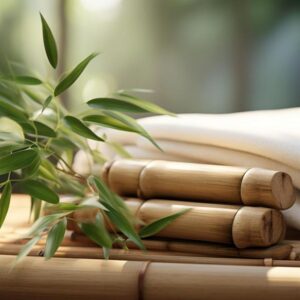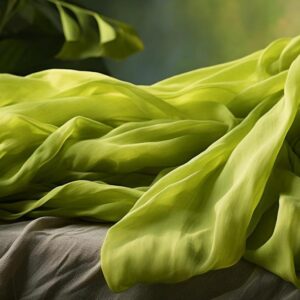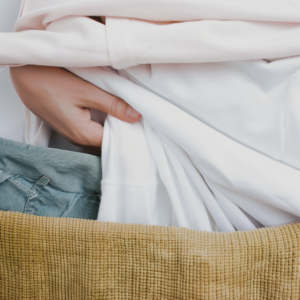Jute: the natural fiber that’s revolutionizing your home decor and your wardrobe
By Ekomfort Updated April 22, 2024
Key Takeaways
- Jute fiber is a natural, resistant, durable and flame-retardant fiber, ideal for eco-responsible fashion and decoration.
- Jute is an ancestral plant grown mainly in Asia, requiring little water or pesticides.
- The plant is transformed into a textile fiber through a natural retting process.
- Jute is an excellent material for furnishings, decorative accessories and reusable bags.
- Compared with hemp, jute has a simpler transformation process and a higher yield per hectare, making it more economical to produce.
Video
Jute fiber: the secret of eco-responsible fashion brands
Jute fiber is revolutionizing the fashion industry, offering a sustainable and ethical alternative to polluting synthetic materials. But do you really know the advantages of this still little-known natural fibre? Find out why more and more vegan and eco-responsible fashion brands are turning to jute fibre for their collections.
What is jute fiber and where does it come from?
Jute is a tropical herbaceous plant grown mainly in India and Bangladesh. From its stems is extracted a tough, versatile natural fiber that has been used for millennia to make bags, ropes, carpets and textiles. Today, jute fiber is enjoying renewed interest from the fashion industry, which is keen to reduce its environmental impact.
The unique properties of jute fiber for sustainable fashion
Jute fiber has remarkable characteristics that make it the material of choice for responsible fashion:
- Resistance and durability: stronger than cotton, jute offers excellent resistance over time.
- Biodegradability: unlike synthetic fibers, jute is 100% biodegradable and compostable.
- Low environmental impact: jute cultivation requires less water, fertilizer and pesticides than cotton.
- Thermal regulation: jute offers good insulation, ideal for both summer and winter garments.
- Unique feel: jute has a raw, natural texture that is highly fashionable and appreciated by consumers.
How fashion brands are incorporating jute fiber into their collections
The creative possibilities offered by jute fiber are endless. More and more ethical fashion brands are using it to create original and sustainable pieces:
- Clothes: dresses, skirts, pants, jackets in jute fabric with modern, streamlined cuts.
- Accessories: jute bags, hats and shoes for a natural, bohemian look.
- Lingerie: jute fiber adds softness and breathability to eco-friendly underwear.
- Furnishings: cushions, poufs and rugs in jute for responsible, trendy decoration.
Whether it’s Ekomfort, a vegan fashion specialist, or major brands like H&M with its Conscious range, more and more brands are offering jute fiber collections to meet growing consumer demand for greener, more ethical fashion.
From plant to fabric: the fascinating process of hessian manufacture
By the way, how do we go from jute plants to the canvas we wear on our clothes and accessories? Take a behind-the-scenes look at how this exceptional natural fiber is transformed.
Growing jute: an ancestral plant with many virtues
Cultivated for over 2,000 years, jute is deeply rooted in the history and culture of the Indian subcontinent. This annual plant grows naturally in humid tropical regions, mainly in India and Bangladesh, which account for 95% of global production. In addition to its textile fibers, jute is also valued for its protein-rich edible leaves, its stalks used as fuel and its role in soil fertilization.
Key stages in the transformation of plants into textile fibres
The transformation of jute into fibre takes place in several stages:
- Harvesting: stems are cut by hand, flush with the ground, after about 120 days of growth.
- Rolling: the stems are immersed in water for 2 to 3 weeks to separate the fibers from the woody part.
- Extraction: the bark is peeled off by hand, then beaten to extract the fibers.
- Washing and drying: the fibers are washed with water and then dried in the sun.
- Spinning: the fibers are combed and then spun to obtain an even, strong yarn.
- Weaving: the threads are woven on looms, either mechanical or manual, to produce jute cloth.
This essentially manual process, handed down from generation to generation, enhances ancestral know-how while providing employment for millions of small-scale producers.
The different types of burlap and their characteristics
Depending on the quality of the fibres and the weaving techniques used, different types of jute cloth can be obtained:
- Corchorus fabric, the most common, is made from white jute and is soft and silky.
- The coarser, stiffer mesta fabric, made from tossa jute.
- Thick, resistant sackcloth, used for carrying bags.
- Fine, light and soft fabric for clothing and lingerie.
- Decorative canvas, with a variety of finishes and patterns, for furnishing and decorating.
Each type of fabric has unique properties, adapted to specific uses. What they have in common: exceptional strength and durability.
Burlap, an essential ally for ethical and trendy decoration
Want to give your home a natural, responsible touch? Go for burlap! This raw, authentic fabric is inviting itself into our homes for a trendy, eco-friendly decor.
How to incorporate burlap into your interior design?
Here are some creative ideas for using burlap in your home:
- Floors: rugs, bedspreads, jute carpeting for a warm, cozy atmosphere.
- Wall hangings, wallpaper and burlap frames for a natural, bohemian look.
- On furniture: sofa, cushion and pouffe covers for a raw, contemporary look.
- For windows: curtains, jute blinds for subdued light and optimum insulation.
- On the table: placemats and a burlap table runner for a touch of rustic chic.
Combined with natural materials such as wood or linen, burlap brings warmth and authenticity to an interior. Its raw look also contrasts with more industrial elements like metal for a unique style.
Creative ideas for making your own decorative objects from burlap
With a little imagination, you can turn burlap into an original, eco-friendly decoration:
- Burlap baskets to organize your home.
- Jute planters for a bohemian look.
- Jute lampshades and pendants for soft, natural lighting.
- Jute cushions and poufs filled with kapok or hemp for soft comfort.
- Plant paintings in burlap, moss and dried plants for a green DIY decor.
Easy to sew, glue or braid, jute canvas lends itself to all your creative desires while promoting an ecological and economical material.
The best places to buy quality burlap
Here is a selection of reference stores for your burlap decorating projects:
- La Fabrique Ecologique : organic jute canvas made in France, from decoration to fashion.
- Ekomfort : a cutting-edge selection of decorative objects in jute and other natural materials.
- Maison Pratic : a wide range of jute cloth by the meter, on rolls or in bags.
- Natura : organic and fair-trade jute furnishing fabrics.
By choosing committed, transparent suppliers, you can be sure you’re buying quality jute fabric produced under ethical, sustainable conditions.
Burlap bags: the essential accessory for a zero-waste lifestyle
Looking for an eco-friendly alternative to disposable plastic bags? Adopt the burlap bag! Resistant, infinitely reusable and customizable, it’s the perfect ally for consumers committed to a zero-waste approach.
Why choose a burlap bag over a plastic one?
Here are 5 good reasons to swap your plastic bags for jute bags:
- Durability: strong and resistant, a jute bag can be used for years without being damaged.
- Ecology: biodegradable and recyclable, jute bags don’t pollute like plastic.
- Practical: lightweight, foldable and washable, it goes everywhere with you, from shopping to sports.
- Aesthetics: with its natural, authentic look, it complements any style.
- Ethical: made from fair-trade jute, it ensures a decent income for small-scale producers.
Opting for a burlap bag means adopting a simple, economical and responsible approach to everyday life. A smart, trendy accessory for greener consumption.
The different types of hessian bags and their uses
Far from being confined to the traditional shopping bag, the jute bag comes in a multitude of models:
- Shopping and grocery bags: ideal for bulk and zero-waste shopping.
- Weekend tote bag: perfect for road trips or picnics.
- Bread and bulk bags: to buy bread and dry foods in bulk.
- Shoulder bag, messenger bag: for practical, trendy everyday use.
- Backpacks and sports bags: for hiking and eco-friendly gym sessions.
Small or large, natural or printed, jute bags adapt to all your needs and desires. You can even customize them for a unique look.
Our tips for personalizing and maintaining your burlap bags
To give a second life to your jute bags or personalize them, let your creativity do the talking:
- Customization: embroidery, painting, printing, patchwork for unique bags.
- Repair: a snag? A few stitches or a nice seam will extend its life.
- Reconversion: at the end of its life, it can be transformed into a doormat, a basket or a pouch.
Maintenance couldn’t be simpler: regular dusting is all that’s needed, with the occasional machine wash to freshen things up. Jute bags are accessories that are easy to live with and maintain.
Jute vs hemp: the match of natural fibers for responsible fashion
Jute and hemp are the two big stars of ecological fibers. But what are their differences and fashion advantages? A brief comparison of these stylish green allies.
Similarities and differences between jute fiber and hemp fiber
Despite their family resemblance, jute and hemp each have their own specific characteristics:
Common points :
- Plant-based and natural, chemical-free.
- Ecological cultivation, without GMOs or pesticides.
- Resistance, durability and easy-care fibers.
- Insulating, breathable and antibacterial properties.
- Biodegradability at end of life.
Differences :
- Origin: jute comes from India, hemp from Europe and Central Asia.
- Cultivation: jute grows in tropical zones, hemp in temperate regions.
- Cost: jute is cheaper to produce than hemp.
- Appearance: jute is rougher, hemp softer and silkier.
- Fashion uses: jute is ideal for accessories, hemp for close-fitting garments.
Jute and hemp are complementary: using them together multiplies the creative possibilities of eco-responsible fashion.
Their respective benefits for the environment and ethical fashion
Jute and hemp are both champions of ecology, with major environmental advantages:
Jute :
- Grows without fertilizers or pesticides and enriches soils by fixing nitrogen.
- Requires little water and no irrigation, saving this precious resource.
- Absorbs atmospheric CO2 during growth.
- Processed without chemicals, with natural retting.
Hemp :
- Adapts to all types of soil, even poor, and resists pests.
- Requires few or no inputs in organic farming.
- De-pollutes and regenerates soil thanks to




